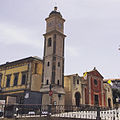Sant'Antioco
| Sant'Antioco | ||
|---|---|---|

|
|
|
| Country | Italy | |
| region | Sardinia | |
| province | South Sardegna (SU) | |
| Local name | Santu Antiogu | |
| Coordinates | 39 ° 4 ' N , 8 ° 27' E | |
| surface | 88 km² | |
| Residents | 11,026 (Dec. 31, 2019) | |
| Population density | 125 inhabitants / km² | |
| Post Code | 09017 | |
| prefix | 0781 | |
| ISTAT number | 111071 | |
| Popular name | Antiochensi | |
| Patron saint | Sant'Antioco | |
| Website | Sant'Antioco | |
 Sant'Antioco, Piazza Italia |
||
Sant'Antioco is a municipality in Sardinia in the province of Sud Sardegna with 11,026 inhabitants (as of December 31, 2019).
geography
Sant'Antioco is a seaside resort and tourist port on the same, to the mainland by a 5 km long isthmus connected the island Sant'Antioco . The fraction Maladroxia is a major tourist resort.
The community also includes the two uninhabited islands of Isola la Vacca and Isola il Toro , south of Sant'Antioco .
The neighboring municipalities are Calasetta and San Giovanni Suergiu .
history
The place lies at the foot of the restored castle ruins Forte Su Pisu , also called Forte Sabaudo , which was built in the 18th century on the remains of nuraghi and was completed in 1812. Here you can find the remains of one of the oldest Phoenician settlements in Sardinia (8th century BC) and the ancient port city of Sulki (also Sulky), which later fell under Roman rule. The largely intact labyrinthine tunnel system with Punic niches (burial chambers) under the old town is evidence of this . Some houses even today use the ancient burial chambers as cellars. However, only the catacombs under the parish church Basilica di Sant'Antioco and the grottoes next to the ethnographic museum are open to the public . The city was abandoned in the Middle Ages. A settlement did not emerge again until the middle of the 18th century.
Attractions
Of the three naves of the 12th century Basilica di Sant'Antioco parish church consecrated to Antiochus von Sulci , only the middle one remained. Nearby are other archaeological finds, a Punic sacred site, a tofet , and various Roman remains, including a stone mausoleum and the menhirs Su Para e sa Mongia .
In addition to the ethnographic museum mentioned, there is the archaeological town museum "Ferruccio Barreca", which houses important evidence from the pre-Uragic, Nuragic, Phoenician-Punic and Roman times, the maritime Museo del Mare, as well as the Byssus museum with a permanent exhibition on the processing of Byssus, equipment and products.
See also
Web links
- Official website of the municipality (Italian)
- Sant'Antioco.it (Italian)
- Information from comuni-italiani (italian)
Individual evidence
- ↑ Statistiche demografiche ISTAT. Monthly population statistics of the Istituto Nazionale di Statistica , as of December 31 of 2019.
- ↑ Monumenti e Archeologia | Comune di Sant'Antioco. Retrieved February 10, 2020 (Italian).
- ^ Museo del Bisso di Chiara Vigo. Retrieved February 10, 2020 (Italian).








